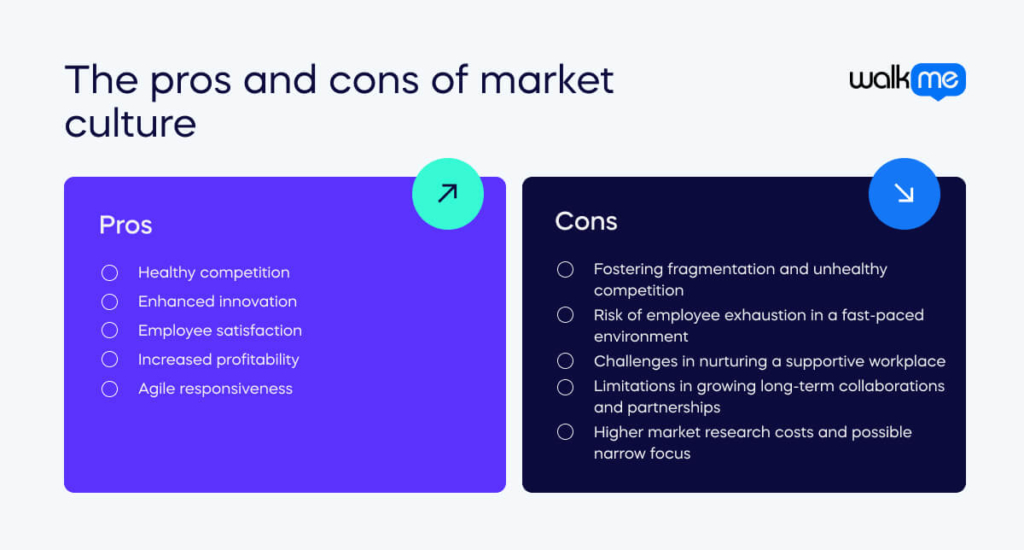How does the way your organization does things affect productivity?
Market culture seeks to improve employee productivity for higher revenue, but treating people like efficient machines has limitations, too.
This drawback is why some organizations instead choose other cultures, such as hierarchy culture, clan culture, or adhocracy culture.
If implemented poorly, market culture might drive high employee dissatisfaction, leading to high voluntary employee turnover. However, there are ways to reduce the negative impacts while maintaining staggering productivity.
We will show you how to try a market culture without hurting employee retention. To do this, we will explore what market culture is. We will also cover its key traits, pros, cons, examples, and how your HR team can promote it.

What is market culture?
Market culture values high profits and dominance. It’s focused on results and customers. It fosters competition, which attracts ambitious talent.
Big companies like Amazon and Apple have this culture. It demands constant innovation and performance, but this can hurt employee satisfaction. It is common in many industries, including tech, aerospace, and media.
What are the key characteristics of market culture?

Review these characteristics of market culture. Then, consider whether a market culture is right for your organization. These include being competitive, focusing on results and the customer, and completing tasks efficiently. These traits create high market value in this profit-driven culture.
Competitiveness
Competitiveness is a key part of market culture. It fosters rivalry among competitors and employees. However, too much internal competition can hinder collaboration. This issue is common in consulting firms and law offices.
For instance, former General Electric CEO Jack Welch famously ranked employees and fired the worst. Welch believed this approach improved company performance. He kept top talent and helped dismiss employees by removing them from bad situations.
Focus on results
In market culture, results are key. They focus on performance and achievements measured by profit and market share.
Amazon exemplifies this ethos, utilizing the DMAIC (Define, Measure, Analyze, Improve, Control) methodology to perpetually refine processes and metrics.
This approach is detailed in “Working Backwards,” authored by former Amazon employees. It illustrates the company’s commitment to driving success through a relentless pursuit of efficiency and effectiveness.
Customer emphasis
Market-oriented companies prioritize customer focus, shaping decision-making in product development, in-store and online experiences, and customer service endeavors.
Hard customer research supports strategic initiatives. It echoes Amazon’s famous mission statement. The statement puts customers at the forefront.
Amazon is committed to understanding and meeting customer needs. It relentlessly pursues innovation and excellence. Amazon sets a standard. Businesses must meet it to excel today.
Efficient task completion
Completing tasks fast is a cornerstone of market culture. It means swift execution and streamlined processes. This culture tackles tasks promptly and methodically to meet market demands and outpace competitors.
This efficiency is vital. It allows us to stay agile and responsive in fast, changing markets. It lets companies use new opportunities and handle challenges well.
Efficiently finishing tasks creates a culture of accountability and productivity. It empowers employees to take on their duties and contribute to success.
What are some examples of market culture?
Learning the definition and characteristics of market value is good, but examples can demonstrate how it works in practice.
Take a look at these examples of how market culture has worked in enterprise settings, and note the sections below each example explaining what we can learn from it.
Amazon
Amazon’s success stems from its adept adoption of a market culture marked by customer obsession, innovation, and operational excellence.
Founder Jeff Bezos instilled a relentless focus on customer needs, shaping everything from product offerings to service delivery.
The company prioritized agility, continually iterating and experimenting to stay ahead in dynamic markets.
Embracing data-driven decision-making and technologies like AI, Amazon optimized operations and personalized customer experiences.
Its commitment to long-term growth over short-term gains fueled investments in logistics, cloud computing, and expansion into new markets.
Amazon’s market culture fosters adaptability, innovation, and customer-centricity, laying the foundation for its remarkable success.
What can we learn from this example?
Embracing data-driven decision-making and technologies like AI can help you optimize operations and personalized customer experiences. Commitment to long-term growth over short-term gains fueled investments in logistics, cloud computing, and expansion into new markets.
Bluecore
Bluecore, a retail marketing firm, is lauded for its ethical treatment of employees while disrupting traditional marketing paradigms.
Employing a data-centric approach, Bluecore leverages customer insights to drive sales effectively.
Similar to Amazon, Bluecore offers an e-commerce platform without handling product delivery. The company excels in employee satisfaction and is commended for its integrity and ethical business practices.
What can we learn from this example?
Bluecore proves it is possible to maintain high employee ethics while achieving high revenue year after year. It also shows that focusing on ethics can yield higher profits rather than reducing them due to an assumption that treating employees well will reduce productivity.
General Electric
General Electric (GE) successfully adopted a market culture by prioritizing customer needs, embracing innovation, and fostering a results-driven mindset.
Under leaders like Jack Welch, GE implemented strategies to decentralize decision-making, empowering employees to act swiftly and responsively to market demands.
The company leveraged market research to develop customer-centric products and services, ensuring relevance and competitiveness. GE’s embrace of Six Sigma and Lean methodologies enhanced efficiency and quality, driving continuous improvement and cost savings.
GE achieved sustained success by aligning its operations with market dynamics and customer preferences, demonstrating the effectiveness of a market-oriented approach in driving business growth and profitability.
What can we learn from this example?
GE shows us that Six Sigma and Lean methodologies can enhance efficiency and quality, driving continuous improvement and cost savings within an effective market culture.
What are the advantages of market culture?
Big companies have used market culture many times throughout history. Several advantages show why and how well it works. The first is that market culture creates healthy competition within any market.
Healthy competition
Healthy competition is part of market culture. It encourages employees to strive for success. It drives growth and teamwork.
It fosters and strengthens relationships. Individuals work towards common goals. With a focus on fair play and sportsmanship, competition promotes mutual respect among colleagues.
Employees develop valuable skills such as problem-solving and resilience when facing challenges.
Enhanced innovation
Innovation thrives in market culture, which encourages competition. Employees begin to think creatively to gain a competitive edge.
The dynamic environment fosters a culture of experimentation and risk-taking. Competition pushes individuals to explore new ideas and approaches to solve problems.
This continual drive for improvement leads to innovative products, services, and processes.
Employee satisfaction
Employee satisfaction flourishes in market culture as individuals find fulfillment in facing challenges and achieving success.
The dynamic nature of competition fosters employees’ motivation, happiness, and creativity. Recognition of achievements and opportunities for growth contribute to high levels of job satisfaction.
Employees feel valued and empowered to contribute to the organization’s success.
Increased profitability
More competition and innovation can make companies more profitable. This is over the long term.
Competition from inside and outside drives organizations. It makes them maximize efficiency and effectiveness.
This approach leads to innovative solutions that attract customers and boost revenue.
Agile responsiveness
Embracing market culture lets companies react quickly. They can respond to shifts and competitor actions.
This agility puts the organization ahead of competitors. It lets them capture much of the market and keep customer loyalty.
They do this by adapting and responding proactively.
What are the disadvantages of market culture?
Despite its advantages, not every organization adopts a market culture. They avoid it due to its many challenges, as shown below. Consider these disadvantages before adopting a market culture within your organization.
Fostering fragmentation and unhealthy competition
Market culture runs the risk of fostering fragmentation and unhealthy competition among employees.
It emphasizes individual goals and rewards. This action can create silos in the organization. They hinder collaboration and cohesion.
This split may negatively impact teamwork and synergy. It will hurt the organization’s effectiveness and success.
Risk of employee exhaustion in a fast-paced environment
Market culture is fast-paced. It can make employees tired and burned out.
The pressure to meet tough goals in a short time can strain employees, reducing morale, productivity, and job satisfaction.
Over time, this can contribute to high turnover rates and diminished organizational performance.
Challenges in nurturing a supportive workplace
Market culture is relentlessly focused on competition and results. This focus may sideline efforts to build a supportive work environment.
This neglect of employee well-being and emotional support can foster a culture of individualism and self-interest, eroding trust and camaraderie among colleagues.
Low morale and engagement may suffer without support. This will hurt the company’s culture and performance.
Limitations in growing long-term collaborations and partnerships
The intense focus on competition and individual success inherent in market culture can challenge building and maintaining long-term partnerships and collaborations.
Organizations may prioritize short-term gains over building lasting relationships. This focus could cause them to miss chances for mutual growth and innovation.
Balance is key. Organizations need to stay competitive and cooperate internally. This cooperation is vital for thriving in fast-changing markets.
Higher market research costs and possible narrow focus
Market culture always chases success. This action may raise research costs and focus only on immediate demands.
Organizations fixated on short-term goals may overlook emerging trends or fail to adapt to evolving customer needs.
This tunnel vision approach can limit innovation and strategic foresight, ultimately hindering long-term growth and sustainability.
Balancing market-driven strategies with a broader perspective is essential for organizations to remain agile and responsive in an ever-changing business environment.
How can your HR team promote market culture?
While navigating the challenges inherent in a market culture, leveraging its positive aspects, like healthy competition and customer focus, can enhance your organization’s performance and profitability.
Here’s how HR can cultivate elements of market culture within your company:
Offer performance-bases incentives
Revise your compensation strategy to align with performance-based rewards. Recognize and incentivize top performers with higher salaries, bonuses, and prestigious learning opportunities, attracting competitive candidates who value monetary incentives.
Roll out an employee recognition program
Establish an employee recognition program centered on achieving results and meeting targets. Utilize frameworks like OKRs or KPIs to track progress and tailor recognition initiatives to suit your organization’s unique dynamics.
Become customer-centric
To serve your customers best, you need to be able to meet their needs. And a market culture helps you achieve this when you emphasize a customer-centric approach in every process.
By providing comprehensive training across departments to understand and address customer needs effectively.
Implement systems to reward employees for exceptional customer-focused behaviors, aligning with the market culture’s customer-centric ethos.
Hire productivity-driven staff
Recruit driven individuals who prioritize advancing productivity and profitability. Clearly articulate these expectations in job postings and selection criteria, utilizing interview questions to assess candidates’ goal-oriented mindset and track record of achievement.
Implement strong leadership
Cultivate strong leadership that inspires peak performance and ambition among employees. Embrace transformational and servant leadership styles to motivate and serve as role models.
Identify and develop future leaders through leadership development plans and coaching opportunities for current leaders.
Seek input from customers
Competitive markets often foster brand loyalty, where customers favor one brand for its offerings. To enhance competitiveness and gain an edge, companies can continuously harness customer feedback to improve the overall customer experience.
This approach can also alleviate the burden on market research teams, who might otherwise dedicate time to studying competitors. Cultivate a culture centered on customer feedback and responses to gain insights tailored to the company’s specific customer needs.
Ensure market culture is best for your organization
Market culture can look attractive with its productivity gains and ability to please C-suites with its focus on impressive results and high competitiveness. But it’s not the best fit for every organization.
Ensuring that a market culture best fits your organization before initiating a cultural shift is crucial for long-term success.
A thorough assessment of organizational values, goals, and market dynamics is essential to determine compatibility.
Conducting employee surveys, stakeholder consultations, and market research helps gauge readiness and identify potential barriers.
Pilot programs or small-scale experiments can test the viability and effectiveness of a market-oriented approach before full-scale implementation.
This systemic approach minimizes risks and maximizes the likelihood of a successful cultural transformation aligned with organizational objectives. It allows you to optimize your use of market culture for high profits for years to come.

Common Questions
By balancing performance metrics with dedicated time and rewards for experimentation (like hackathons), enterprises can preserve innovation while maintaining market-driven accountability.
It ensures competitiveness is purpose-driven—grounded in delivering customer value rather than internal rivalry—resulting in sustainable growth and market responsiveness.
Leaders should act when high turnover, disengagement, or stress indicators spike—rebalance incentives and collaborate-focused initiatives to preserve long-term productivity.
Monitor collaboration metrics and foster shared goals. Introduce team-based rewards and rotate roles to reduce silos and reinforce collective performance.

